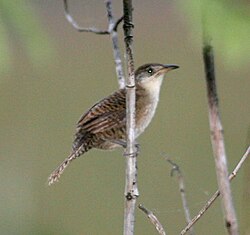| Zapata wren | |
|---|---|
 | |
| Scientific classification | |
| Kingdom: | Animalia |
| Phylum: | Chordata |
| Class: | Aves |
| Order: | Passeriformes |
| Family: | Troglodytidae |
| Genus: | Ferminia Barbour, 1926 |
| Species: | F. cerverai |
| Binomial name | |
| Ferminia cerverai Barbour, 1926 | |
 | |
The Zapata wren (Ferminia cerverai) is a medium-sized grayish-brown bird that lives in dense shrubs of the Zapata Swamp, Cuba. It is the only member of the monotypical genus Ferminia, which is endemic to Cuba and endangered. This species was first described in 1926 by Thomas Barbour and named after its co-discoverer, Fermín Zanón Cervera.

